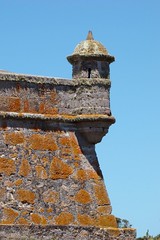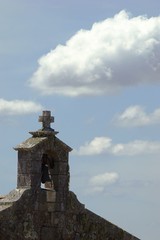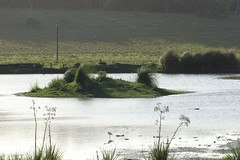Available in Spanish: Fortaleza y parque de Santa Teresa
 The Fortress of Santa Teresa is near the coast of the Atlantic. Its construction began in 1762, by the Portuguese. The Spaniards came, took over it, and finished it. After undergoing wars and conflicts of all kinds, it was abandoned and got deteriorated seriously. In 1928 an archaelogist took upon himself the task of rebuilding it, and that's why it's still there in our time. Today it's a museum and it marks the entrance of the Santa Teresa National Park.
The Fortress of Santa Teresa is near the coast of the Atlantic. Its construction began in 1762, by the Portuguese. The Spaniards came, took over it, and finished it. After undergoing wars and conflicts of all kinds, it was abandoned and got deteriorated seriously. In 1928 an archaelogist took upon himself the task of rebuilding it, and that's why it's still there in our time. Today it's a museum and it marks the entrance of the Santa Teresa National Park.That day, at mid-morning, we left the La Paloma bus terminal without a clear idea of what the place was like that we were about to visit, and thinking maybe we could step by nearby Punta del Diablo on our way back. The bus we were on finished its route in Chuy, on the frontier with Brazil, and entered each and every city and town in the way, so the trip took twice the time it should have.
 As soon as we saw the Fortress we (hastily) got off the bus. Right away we realized it hadn't been a good idea, as the bus went on its way toward the interior of the National Park, leaving us under the sun falling vertically on us. There was none of the sea breeze that had been with us on other occasions, and to top it off, the stone walls of the Fortress showed no opening, or at least an overhang. So that we could postpone a walk that promised to be extremely hot, and also to avoid food poisoning later, we took out our ham-and-cheese sandwiches and ate, sitting on a rock carefully chosen so that the nearest wall provided shade (not much of it).
As soon as we saw the Fortress we (hastily) got off the bus. Right away we realized it hadn't been a good idea, as the bus went on its way toward the interior of the National Park, leaving us under the sun falling vertically on us. There was none of the sea breeze that had been with us on other occasions, and to top it off, the stone walls of the Fortress showed no opening, or at least an overhang. So that we could postpone a walk that promised to be extremely hot, and also to avoid food poisoning later, we took out our ham-and-cheese sandwiches and ate, sitting on a rock carefully chosen so that the nearest wall provided shade (not much of it).It turned out, when we went around the Fortress, that the entrance gate was on the other side. Once inside we found shade and cool in the great stone halls that were used, long ago, to house soldiers and officers, to prepare their meals, to pray and hear Mass, to repair weapons, to shoe horses, and to store ammunition. There were, as is usual, ancient and modern weapons in heterogeneous sets, cannonballs, ordinary objects rescued from the past, old flags and banners, uniforms, a chapel with a tearful Virgin Mary, and even a latrine room.
The contrast between the inside of these dark chambers, with walls one metre thick, and the sweltering outside, was terrible. From the Fortress's watchtowers you could feel some breeze, but that was all. As my mood was getting rather nasty (this I believed I noticed myself, and Marisa confirmed it), we wrapped up our visit and went down to the beach, across the park's camping site; on our way we bought return bus tickets, so we'd be sure to have seats.
As soon as I saw the sea my fastidiousness disappeared. The heat didn't matter anymore. In fact, it was a blessing, encouraging me to get right into the water and enjoy it. The problem was the wind... again the wind. At one point the fine, almost colourless sand, started flying around and stinging our legs. Our things (clothes, towel, camera...) were being covered in sand. A few steps from us, the wind grabbed an umbrella and sent it tumbling away to an amazing distance, followed closely by its owner.
But the waves were fabulous, the beach was wide and quiet, and in the water the wind and the sand didn't exist.
I had to concede in the end. We took the sand off our stuff and retreated. On a bend in the road we had some late mate (which had been impossible before, with so much sand flying around), and then we went into the heart of the park.
The park is quite large... not huge, but rather large for a casual walk. There were a lot of tall palm trees, those stereotypical palm trees with smallish leaves all bunched up at the top, but also leafy trees and lots of flowers and bushes. Where one would've expected park rangers or guides there were five individuals who, on seeing our approach, seemed to wage a short silent battle of mutual glances to decide which one of them would move and speak to us. We were given a map and at the same time the advice not to pay attention to it. We walked on, therefore, following verbal directions, among gigantic trees with a smooth, hard, plastic-looking, lustrous bark, and accompanied by the squeaks and cries of an immense crowd of parakeets.
Thus we came to the Pajarera. Despite its name, suggesting a bird cage, it had not only birds (of various species, from chickens to a tucan) but also monkeys and rabbits, along with a couple of cats which apparently were part of the staff; they let visitors call and pet them, and from time to time they sat down and looked intently (as if in a trance) into the cages of the smaller birds.
 Nearby there was a small lagoon, with palm trees on one side and a kind of wooden balcony or pier on the other. In the lagoon there were ducks, and under the balcony, hidden among the grass and the mud of the shore, an otter. A group of kids, delighted at the sight of such a rare animal, debated whether it was a giant rat, a kind of hamster or a carpincho.
Nearby there was a small lagoon, with palm trees on one side and a kind of wooden balcony or pier on the other. In the lagoon there were ducks, and under the balcony, hidden among the grass and the mud of the shore, an otter. A group of kids, delighted at the sight of such a rare animal, debated whether it was a giant rat, a kind of hamster or a carpincho.The time to go back was nearing, so we had to forfeit the chance of watching the sunset in the park. Clearly we should've gone there first, into the green and the shade, and then to the Fortress, but that's how it went, and it was a good day. It was the third in La Paloma, and the last night of our stay there. Next stop: La Pedrera.
To be continued...
















No comments:
Post a Comment
Note: Only a member of this blog may post a comment.